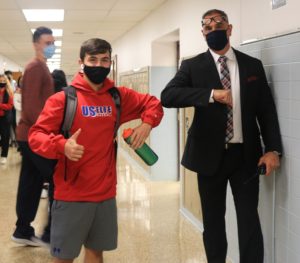What’s it like to live through a historic time? Rutherford High School students are recording that with photography that is displayed now and will be packaged into the yearbook later.
The display project came about in response to “low energy” in the school, and a determination to perk things up by showing friends in action. The Yearbook Club, which always relies on photography, is having to think differently, too, as it plans the definitive keepsake of the student body.
“The Rutherfordian yearbook is not just a memory book. It is also a record in time,” said Adviser Veronica Grillo. “It’s important that we not only incorporate the students’ lives within the school, but also that we are acknowledging anything significant that happens throughout the year. Naturally, this means we’ll have a focus on COVID.”
The yearbook’s pages are typically filled with photos of events like dances, pep rallies, and crowded football games, but the numbers of those occasions have dropped dramatically. Club members who work all year to assemble that book will dig deeper into personal perspectives.
“We plan on highlighting the realities of life and presenting students’ opinions, feelings, and experiences during the pandemic and this school year,” Grillo said. “We also intend to have a little fun with it.”
Expect the yearbook to show examples of Zoom-style learning, but also lifestyle segments such as “COVID Hair, Don’t Care!”
To fill the void left by events that were canceled and went virtual, the Yearbook Club has created a monthly photo competition to collect a solid inventory of content. Gift certificates to Rutherford businesses are incentives to get snapping and submitting.
Their work won’t be printed, bound and released until the end of the school year, but the school’s Assistant Principal has taken steps to share pandemic-perspective photos now. Nicholas DeBari formed the idea after noticing “low energy” in hallways that are often noisy as students switch classes. With half the students learning from home each day and 6-foot spacing for the ones on-site, the normally bustling High School lacked its buzz.
DeBari sought to spark things up by showing students their colleagues on two widescreen TVs. Mounted in heavily trafficked spots, the TV screens are used to announce upcoming events and remind students of deadlines. Now, those messages are mixed with photos of students making their way through the new normal.
“I asked a handful of students to capture some images showing what it was like to be a high school student in 2020,” he said. “They came back with photos of empty hallways and cautionary signage.”
Undeterred by that solemn response, DeBari sent students back to the task with a new perspective. The second-round results show students – wearing masks and standing separately, but with smiles wide and thumbs up.
“Showing those photos on the hallway TVs reminds students of their friends learning remotely that day, and sends a positive message that we are all making this work together,” DeBari said.



